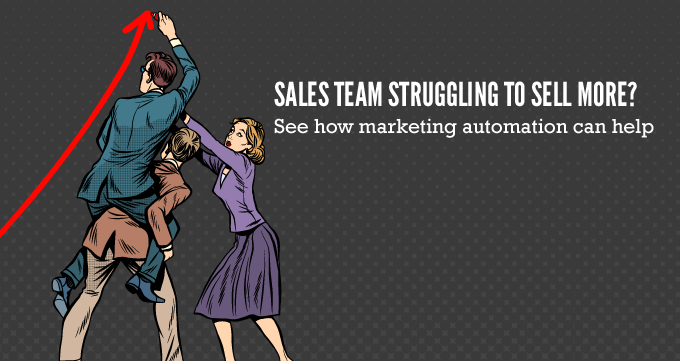 Amit was having an exceptionally bad day. No lead seemed interested in his product, despite calling dozens of them. He had been a sales guy for over 3 years, he knew that he wasn’t giving them a wrong pitch – the leads, just weren’t right.
Amit was having an exceptionally bad day. No lead seemed interested in his product, despite calling dozens of them. He had been a sales guy for over 3 years, he knew that he wasn’t giving them a wrong pitch – the leads, just weren’t right.
Exactly one floor above, Namrata – the marketing head wasn’t doing much better. Despite the sales team working diligently, the most promising inbound leads did not convert and their revenue was taking a hit.
At the end of everyday, Namrata creates an excel sheet with all the inbound leads who have come in that day. It is typically a long list – for there are leads from their PPC campaigns, social media and also direct phone enquiries. She forwards it to the sales head for them to work on.
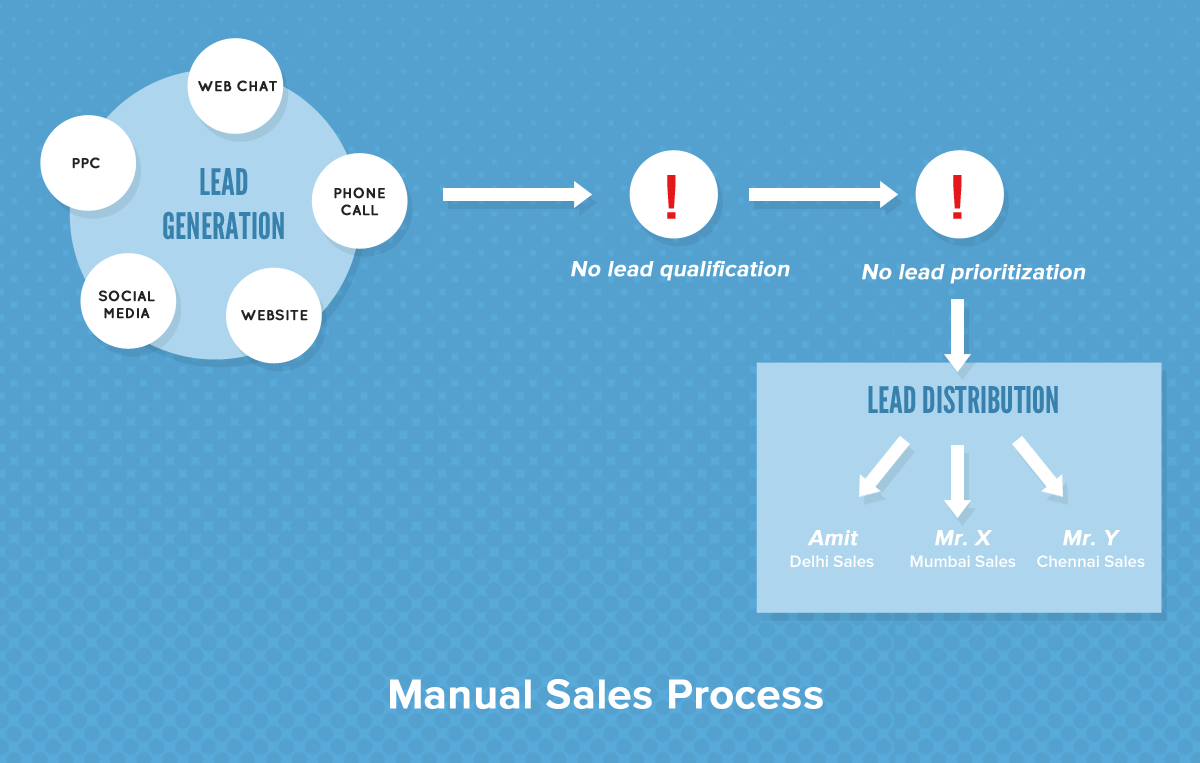 This list gets divided among the sales people (maybe according to lead’s geography) and they get to work – reaching out to the leads and understanding why they contacted their company in the first place. That was how Amit got his lead list – a bunch of names, with contact information from a particular area, who had shown an interest in their services. At first glance this process seems alright, in fact a lot of companies follow it (including yours?). However, it is because of this process that Amit and Namrata are having a problem.
This list gets divided among the sales people (maybe according to lead’s geography) and they get to work – reaching out to the leads and understanding why they contacted their company in the first place. That was how Amit got his lead list – a bunch of names, with contact information from a particular area, who had shown an interest in their services. At first glance this process seems alright, in fact a lot of companies follow it (including yours?). However, it is because of this process that Amit and Namrata are having a problem.
Problem 1. Whom to call?
Amit’s problem is a matter of Lead Qualification. All the leads from a particular location are assigned to him, without checking whether they are really interested in buying. The lead might just be interested in the the new e-book the marketing team created, or could just be enquiring for a friend. In short, the lead is just not ready to buy (yet) and obviously a dozen phone calls from Amit cannot make him. In fact, Amit will just become a pesky sales guy who irritates the lead (no wonder he is having a bad day).
Problem 2. Of the ‘good’ leads, whom to call first?
Namrata’s problem is that she has no way to prioritize leads before she hands them over to sales. She has a list of generated leads, but no insights into their behavior. Result – She passes the leads along, but sales people have no idea whom to call first. If lead A submits an enquiry on the pricing page, well he has a buying intent. However, if Lead B submits an enquiry on pricing and spends a lot more time browsing the other website pages, he is a little more interested than Lead A. Amit should be calling Lead B first.
But, since their process is manual, they cannot make that distinction. Their present form of lead capture tells them that both lead A and B are equally interested, as it cannot track the website activity of the leads beyond the first touch point. By the time Amit calls Lead B, either he would no longer be interested, or worse, he would have been wooed by the competition.
Solution – Marketing Automation Software
Both these problems can be solved with Marketing automation software. Yes – Marketing automation, despite the name (or maybe because of it) can impact sales! In fact 77% of CMOs at top performing companies indicate their most compelling reason for implementing marketing automation is to drive up revenue.
How can Marketing Automation Software improve Sales ROI?
Namrata’s and Amit’s problem, though critical is still only a part of the whole picture. The major factor is that the customer’s buying journey has changed. He connects with you through multiple channels, researches you online, compares you against competition and forms his own opinions before coming to you. Actually, 60% of his mind is made up before talking to the sales guy. So, if Amit wants a shot at closing the deal, he needs to be aware of all these interactions before making the first call. Here is where a marketing automation software can help! It impacts the whole process in 5 essential ways that helps the sales team close more deals.
1. Organizing the captured leads
Namrata’s team collates leads from multiple channels (like social media, third-party sites and so on) with minimum tools.
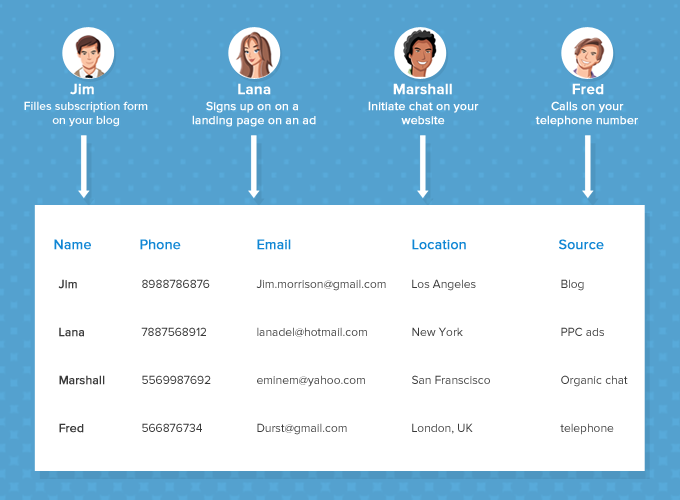 They manually gather the leads from every source and pass them on to the sales team to work on. Not only is this time consuming, but it is also terribly error prone. Regardless of how well they try, the sales team will have to wait at least 24 hours before contacting the leads. Worse, if some leads get lost during the collation process, the sales team won’t reach out to them at all!
They manually gather the leads from every source and pass them on to the sales team to work on. Not only is this time consuming, but it is also terribly error prone. Regardless of how well they try, the sales team will have to wait at least 24 hours before contacting the leads. Worse, if some leads get lost during the collation process, the sales team won’t reach out to them at all!
A lot of companies follow this exact same procedure (maybe even yours?). However, there is a simpler way to do it. With a marketing automation software, lead capture is more organized. The leads who come in through marketing efforts are automatically updated in a single platform, without intervention. That means, Namrata does not have to spend time collating the leads. Also, Amit’s team doesn’t have to wait for the leads to reach them – they can get to contacting the leads immediately.
Not only does it save both teams a lot of time and effort, it also ensures that each lead that comes in is recorded without fail! So you can be sure that your sales team reaches every lead captured, without missing a single opportunity – a definite win all around.
2. Identify whom to call & whom to call first
Once the leads enter the sales cycle, they consume valuable bandwidth. Amit has to spend ages following up with them and understanding their requirement. However, not all leads that come in are ready to buy. Which is why, Amit’s leads were not interested in his calls. But while Amit was talking to them, the leads that might have had a good chance of conversion were not contacted (no prioritization), and the opportunity slipped through their fingers.
Great news – with marketing automation, this problem can be avoided! Lead Score and Engagement Score – two metrics that quantify each lead’s buying intent. The higher the scores, the more involved that lead is with the business and should be called first.
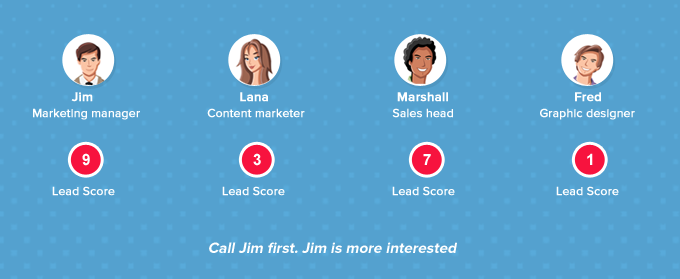
The leads who have a low score can be put in a nurturing cycle by the system, till they seem sufficiently interested. By the end of they cycle or, even during the nurturing cycle, if they reach a particular score that shows their interest, they can be automatically assigned to the sales team.
Now, sales doesn’t have to waste a lot of time in qualification, and can just prioritize follow-ups without wasting time in chasing the wrong leads.
3. Understand lead requirement
Their sales team is smart. Two minutes after talking to leads, Amit and his colleagues have an idea of what the prospect wants and start selling. The problem is that not everyone has the same requirement, and they struggle to keep track of it all (excel sheets really don’t cut it anymore).
With a Marketing Automation Software, the sales team’s approach to selling changes. Amit will have a complete view of the lead’s interaction with the website – what he has downloaded, which page he has visited and so on. He can track the lead behavior and thus have a rudimentary understanding of the lead requirement.

So when he makes that first phone call, Amit can make a customized pitch instead of shooting in the dark. At the very least, he will have a basic idea of what the lead expects and be able to make a good first impression. (See this article from the Content Marketing Institiute that tells you a little more on understanding audience insights).
Now, will that not considerably increase the chances of making a sale?! *Grinning* Yes, I thought so too!
4. Reduce response time
I recently signed up at a local gym and requested a call back to ‘know more’. I don’t know what I could have known more about them – because I never got that call (well, perhaps now I know that they don’t follow-up all that well).
On the other hand, at another fitness center, I got a call within 5 minutes of me signing up! The executive fixed up an appointment with a trainer the very same day and even offered a 10% discount.
Want to guess where I joined? The latter of course!
Response time makes a huge first impression. The faster you reach out once the lead comes in, the better your chances of impressing the prospect and higher the chances of closing the deal. I know it, you know it and even Amit knows it. But, in practice, it fails due to two reasons:
- Man-power crunch: You might not have enough man-power to focus only on incoming leads
- Process delays: Once the lead is in, it is analyzed and then assigned to a particular sales person to contact, which could take quite a lot of time
With Marketing automation, both these problems can be solved.
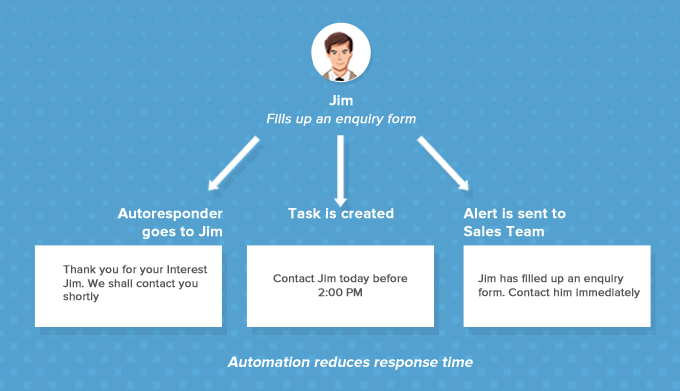 Once the lead signs up, a personalized automated response can be instantly sent to him.
Once the lead signs up, a personalized automated response can be instantly sent to him.
Another way is to send notifications to Amit himself. If Amit knew every time a particular lead was assigned to him – or that a lead has filled an enquiry form, he could connect with them faster and gain an edge in closing the deal. To make it even simpler, a task can be automatically created for Amit, at a particular time so that the opportunity is not forgotten.
5. Increase cross-selling or up-selling
It’s not just new leads that generate revenue. Jack, who’s a paying customer, can choose to move to a higher plan, Johnny may think that he wants to get two flats from you and not just one, or perhaps, Jill decides that she is interested in a Creative Writing course in addition to Literature.
Regardless, the potential of an existing customer to buy from you again is extremely high. In fact, for small businesses in the FMCG market, repeat customers are the golden geese.
The catch is (of course there is a catch!) that these customers won’t automatically buy from Amit every time he calls. They need to be nurtured, developed a relationship with, before they trust him enough to buy from him again.
And how can such a relationship be built? Why, with regular, value adding emails of course! Are exams nearing? Amit can send an email to all his students with exam tips. Holiday season? He can send them season’s greetings. A huge festival coming up? Give them more reason to celebrate by sending great offers. Here is a great example of such an email I got:

It is personalized, direct and is sent at time when the content is highly relevant. With marketing automation, such dedicated nurturing is easy. Using a CRM + Marketing automation tool makes effective personalization possible. Drip campaigns and email campaigns can take care of the clients without Amit having to spend additional man hours on this. And regular nurturing means happy customers who are ready to invest more!
Take Away
Sometimes, opportunities slip, not because sales and marketing aren’t doing their jobs properly. It could be because they lack the insights necessary to close the deal. Every lead connects with you across multiple platforms and expects the sales guy (and the business) to be aware of that.
To keep up, the marketing and sales teams need to work together. Amit and his colleagues will need every bit of information about the lead that Namrata’s team can provide. Otherwise, they won’t be able to make a good first impression. The traditional sales funnel is broken because it does not enable communication between the teams – bridging this gap is important. That is where a marketing automation software can help, not just the marketing team, but also sales.
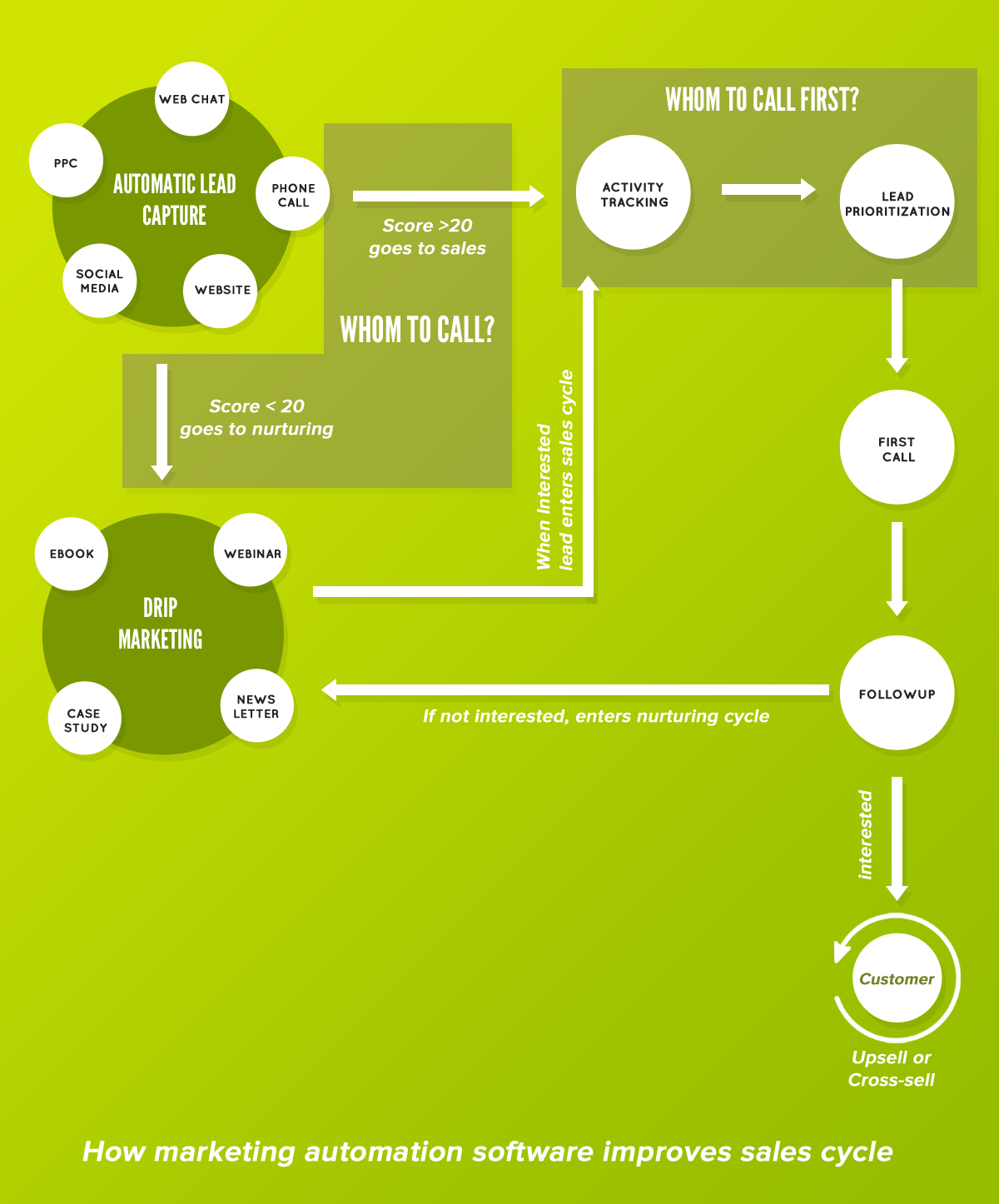 It helps the entire process by plugging the leaks in the system, aligning sales and marketing and thereby improving ROI. That does not mean that once you invest in it, you will find an immediate jump in sales. You will just see that your team is able to better interact with the clients and better cater to their requirements. The Amits and Namratas of your office will be able to focus on improving the customer journey, rather than running around in circles. (Just so you know, we use LeadSquared marketing automation software to help our teams improve their productivity and work together – and they are very happy!)
It helps the entire process by plugging the leaks in the system, aligning sales and marketing and thereby improving ROI. That does not mean that once you invest in it, you will find an immediate jump in sales. You will just see that your team is able to better interact with the clients and better cater to their requirements. The Amits and Namratas of your office will be able to focus on improving the customer journey, rather than running around in circles. (Just so you know, we use LeadSquared marketing automation software to help our teams improve their productivity and work together – and they are very happy!)
And if you are still not convinced, David Neild gives you 7 more reasons for you to use marketing automation software.
P.S. If you are you planning on investing in one, then Check out the basic elements you need in your software before making the purchase decision. Also, drop me a line in the comments section about how you will use your marketing automation software. I am human, not a robot. Will love to hear from you.





